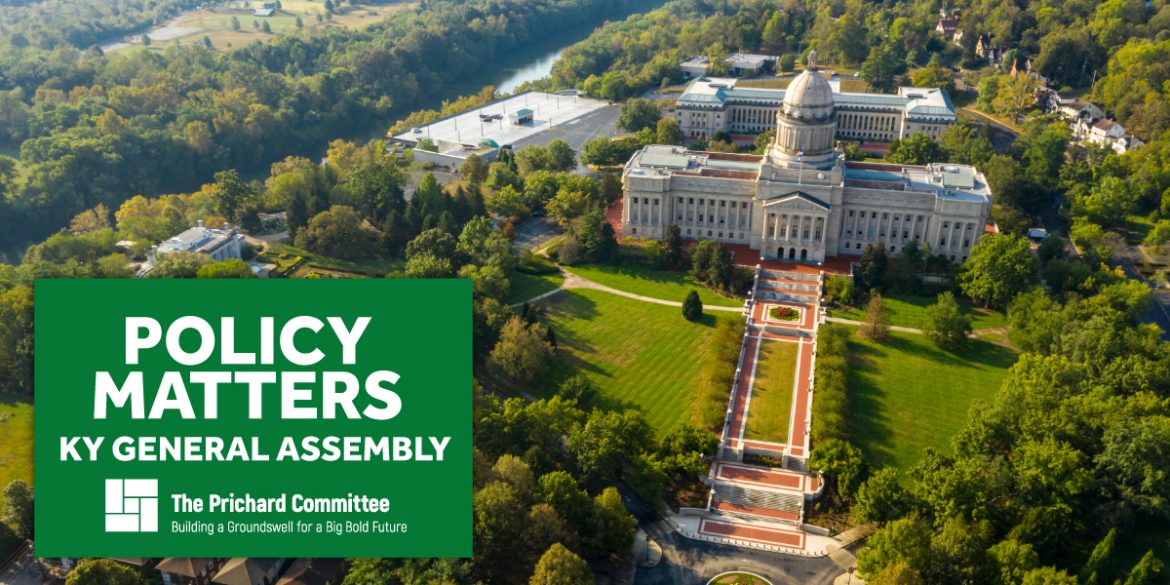A budget for fiscal years 2023 and 2024 was voted out by the Kentucky House of Representatives on Thursday. While continuing many features of the original House Bill 1, the updated budget shows important increases to investments in early literacy, career and technical education, and postsecondary institutions, along with a reduced contribution to teacher retirement. This post will highlight the newest changes and added investments, while raising concerns about early childhood underinvestment.
EARLY CHILDHOOD
Like the original version of HB 1, the revised budget offers no upgrades to funding for child care and preschool. The vision of a universal approach to early childhood, set forth by the Governor, is the right vision during a time of needed education and workforce recovery. The absence of stronger early childhood investments currently in the budget moving through the General Assembly is of significant concern.
Although the Child Care Assistance Program received an added $12 million to support increased rates per child for FY 2021, that increase is not continued in this budget. Our understanding is that federal recovery dollars can be used to keep those higher rates for part and maybe all of the next two years.
High quality child care is an essential investment in getting our youngest learners off to a good start and a key to broader workforce participation by their parents. At a time when we know Kentucky has far too few child care spots available, it is truly dangerous to leave open the possibility that CCAP rates will actually go down in the next two years.
Preschool is a powerful strategy for increasing children’s success in elementary school and in adult life, and Kentucky needs to make that opportunity available to more of our children. The Big Bold Ask calls for added funding to serve four-year-olds from families with incomes up to 200% of poverty, improving on the current 160% cap. In a budget with positive steps for K-12 and postsecondary, the lack of movement on this key investment is disturbing.
K-12 INVESTMENTS
The revised version continues all but one of the upgrades identified in our earlier HB 1 post [https://prichard-backup.com/July/the-house-education-budget-a-quick-look-at-hb-1/], including increasing the SEEK base guarantee, making all-day kindergarten permanent, adding facilities investments, improving transportation funding (short of full costs) and stipends for National Board Certified Teachers, and restoring funding for professional development.
Along with those elements of the original HB 1, the revised version also calls for:
- $30 million in added funding for career and technical education each year
- $11 million in new funding for the Early Learning Initiative each year, dollars that are expected to support the literacy efforts called for in Senate Bill 9.
For the Big Bold Ask, this version fulfills the call for all-day kindergarten, makes progress toward fully funding transportation, and supports teaching quality with its National Board and professional development and early literacy efforts.
A PENSION SHIFT
The revised budget does show one sharp reduction compared to the original HB 1:
- $99 million less in direct payments to the Kentucky Teacher Retirement System for FY 2023 and $85 million less for FY 2024.
We don’t yet understand the implications of that reduction.
POSTSECONDARY SHIFTS
The revised budget further keeps the original version’s increases to financial aid, funding for universities and KCTCS, and performance funding, and adds
- $4.5 million more for higher education institutions in FY 2023 and $16.7 more in FY 2024
For the Big Bold Ask, the revised HB 1 fulfills the request for increased need-based aid and makes progress on overall funding for two-year and four-year institutions.
KEY DIFFERENCES FROM THE GOVERNOR’S PROPOSALS
The House Committee Substitute calls for important added investments education, but differs from the initiatives Governor Beshear called for in his Budget Address. For example it does not include funding universal preschool, fully funding transportation costs, restoring dollars for textbooks and turnaround schools, or creating new social emotional learning institutes. For postsecondary, the House Committee Substitute continues performance funding that the Governor did not include, and the total dollars for institutions are lower than his proposals.
GOING DEEPER
HB 1 has now moved to the Senate, which is likely to propose additional changes that will be followed by work on a shared approach between the Chambers. To learn more, here are links to:
- The House Committee Substitute version of House Bill 1
- Our new charts for early childhood, P-12, and postsecondary elements of the revised bill
- Our summaries of the original House Bill 1 and the Governor’s proposals




Comments are closed.